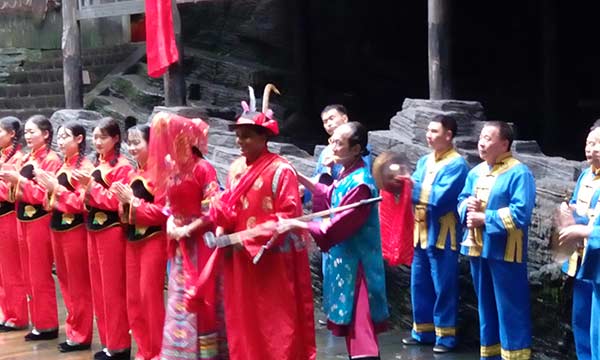Catch the scarf thrown by damsel and marry her
 |
|
A girl in the boat on the stream where a marriage ceremony takes place. [Photo provided to chinadaily.com.cn] |
Yichang city of Hubei province in China is known for the Three Gorges’ dam, the largest hydropower project, which sports 22,500MW in production capacity.
I had irresistible impulse to visit the Three Gorges dam and witness engineering marvel in the world-known Yangtze River. However, when I visited my dream place in June, it was not the Three Gorges dam that impressed me, but a marriage ceremony presented by a tribe.
On the day, it was raining lightly, and we were a group of journalists from different countries of South Asia and South East Asia viewing the area. Together, we took a tourist cruise to reach the other side of Yangtze where the mesmerizing wooden villas at the river’s bank welcomed us. It was stunning – houses on the river bank, just below a lush green jungle, and that was only just the beginning of the spectacular sights we could see.
We took a path along a stream that flows into Yangtze. Flowing down from the high green mountains, the water of the stream is pure, clean and crystal clear. The walk on the path, at the foothill along the murmuring stream, was in itself a joy – a sense of playing at the lap of nature, and the scene grew more fascinating as we walked on. We also saw a damsel emitting youthful radiance sailing a traditional wooden boat. To avoid sunlight, she was under an umbrella, and dressed in beautiful traditional red attire. Spellbound by her beauty and the natural scene, many people captured her in their photos. After walking another 10 minutes, another woman was seen washing clothing at the bank of the stream. She was thrashing clothes against the rock to shake off the dirt, just like people did in the old days. A flock of swans roamed at the other side of the brook, and then we decided to walk upstream and spotted a man fishing with a net. The scene perfectly captured how tribes lived in the past, and while we thought there was nothing more to see, a major part about the life of the tribe was yet to roll up.
We then saw a two-storey wooden house across the stream, with a wooden bridge to cross the boulder strewn stream, also making waterfalls. The way the house was decorated made us understand that some special function was being held, and there were many tourists seated on wooden benches and chairs. We heard a girl making an announcement as reached the destination, stating she would marry the one who catches her scarf she throws from the balcony. She was gorgeous and a lot of the visitors were young, and while many people jumped at the chance, my friend, who is a journalist, was fortunate to catch it. He, with an olive complexion, was excited and his face became red out of embarrassment. He was then called by the woman to join her on the balcony, and a group of other girls proceeded to welcome us. Dressed as a groom, my friend came down with his bride, holding hand in hand. The traditional music went on and the parents, particularly the bride’s father, start sobbing while standing on the balcony as he was marrying off his daughter.
I felt I was at a wedding ceremony in my home village in Nepal. The music was the same – we call it Panche baja, which means the music of five instruments. The bride was in red wedding dress, sporting a red shawl to cover her face. I did not notice whether she wore bangles or not, but every other thing was exactly the same. A red palanquin to carry her to a new home was also on standby as in my country. For a few minutes I seemed to have experienced memory loss. But then, I looked up at the balcony and saw my friend with his new wife pulling down the curtain of the room, celebrating their first night as a couple. I could only see exchange kiss between them behind the curtain and then the light of the room went off.
As I was wondering how could there be so exact similarity in wedding customs between two societies, so far off as 3,000 kilometers at least apart, while returning to the river bank, my newly-wed friend caught my hand. Where is your bride? I asked him. Sir, my friend, it was just a performance. I was chosen as an actor to play the role.
The number of people, mostly tribes, displaced or relocated in course of the construction of 660km long reservoir of 175 meter average depth in the Three Gorges dam is understandable. But after visiting a scenic spot around the Hujin beach in the Yangtze, some kilometers below the dam site, it came to the light how the relocation was managed and how the tribes were enabled to have higher income while preserving their traditional culture. The Tujia tribal people are having as bright life as the electricity produced by Three Gorges has contributed to brightening China, particularly with renewable energy.
The author is sub-editor, The Rising Nepal.
 |
|
A wedding ceremony of the Three Gorges tribe. A Pakistani journalist catches the scarf thrown by a damsel and, as promised, marries her in the show of a tribal wedding ceremony. [Photo provided to chinadaily.com.cn] |




















